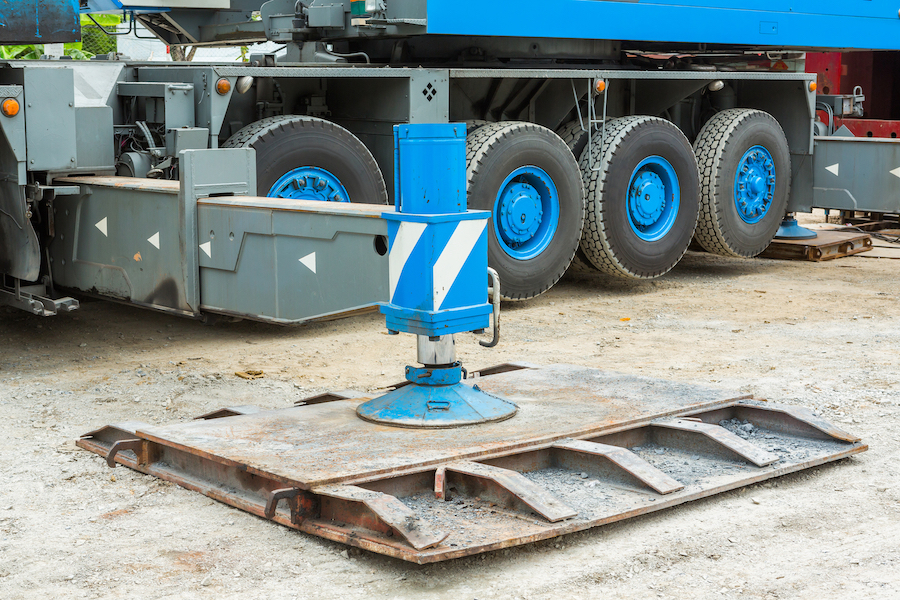
View the complete article here.
Outrigger pads are essential safety equipment used to provide a stable base for heavy equipment. When used properly, outrigger pads help distribute the weight of the equipment across a larger surface area—preventing it from sinking or tipping over. In this article, we will discuss everything you need to know about using outrigger pads safely and effectively—using a crane as an example.
Choosing the Right Outrigger Pad
Before you start using an outrigger pad, it’s essential to select the right type of pad for your crane. Outrigger pads come in various materials—such as wood, plastic, and composite materials. When selecting an outrigger pad, it’s crucial to consider factors like the weight of the crane, the surface you’ll be working on, and the type of outrigger you’re using.
For example—if you’re working on uneven terrain or soft ground, a larger pad with a higher load-bearing capacity may be needed. Similarly—if you’re working on a sensitive surface like a decorative concrete slab, you may want to consider a plastic or composite pad that won’t leave marks or damage the surface.
Proper Procedure for Using Outrigger Pads
Once you’ve selected the right outrigger pad for your crane, it’s time to put it to use. Here is the typical procedure to utilize with most outrigger pads:
- Clear the area: Before setting up your outrigger pads, make sure the area is clear of any debris or obstacles that could affect stability.
- Extend the outriggers: Extend the outriggers on your crane to their full length and lower them onto the ground.
- Place the outrigger pads: Place the outrigger pads on the ground under each outrigger. Make sure they’re centered and flat on the ground, with no air pockets or gaps between the pad and the ground.
- Lower the crane: Once the pads are in place, slowly lower the crane onto the pads. Watch for any signs of movement or instability and adjust the position of the pads as needed.
- Test stability: Once the crane is fully lowered onto the pads, test its stability by performing a light lift or swing. If the crane is stable, you can begin your work.

Safety Precautions
While outrigger pads provide stability and prevent tipping, there are still some safety precautions you should follow to prevent accidents. For that reason, consider these tips:
- Don’t overload the pads: Make sure you’re using outrigger pads that can handle the weight of your crane. Overloading the pads can cause them to sink or tip—putting the crane and operators at risk.
- Check the pads regularly: Inspect the pads before each use to make sure they’re in good condition and free from cracks, chips, or other damage that could affect their performance.
- Follow manufacturer guidelines: Follow the manufacturer’s instructions for using and storing the pads. Improper storage can cause the pads to warp or crack—affecting their load-bearing capacity.
- Use personal protective equipment (PPE): Operators and crew members should wear appropriate PPE—including hard hats, steel-toed boots, and high-visibility vests.
Storing Outrigger Pads
When not in use, outrigger pads should be stored properly to prevent damage and ensure their longevity. Consider these storage tips:
- Clean and dry the pads: Before storing the pads, make sure they’re clean and dry to prevent mold or mildew growth.
- Store flat: Store the pads flat—preferably on a flat surface like a pallet or rack. Storing the pads on their edges or corners can cause them to warp or crack.
- Protect from sun and heat: Store the pads in a cool, dry place away from direct sunlight—as exposure to heat and UV rays can cause the material to break down over time.
- Inspect before use: Before using the pads again, inspect them for any damage or signs of wear and tear. If there are any concerns, replace the pads before using them again.
Conclusion
Outrigger pads are essential safety equipment for crane operators—providing stability and preventing tipping or sinking. When used properly and stored correctly, outrigger pads can help ensure a safe and successful job site. By following the steps and safety precautions outlined in this guide, you can use outrigger pads safely and effectively with your crane.
Looking for the right outrigger pad? Contact Bigfoot Construction Equipment for a quote.
View the complete article here.
What are outrigger pads and why are they important?
Outrigger pads are critical components used to stabilize and support heavy equipment during operation. They distribute the load over a larger area, reducing ground pressure and preventing the outriggers from sinking into soft ground. This helps to maintain stability and safety during equipment operation.
How can outrigger pads be utilized properly?
To utilize outrigger pads properly, first ensure the pads are strong enough for the load and the ground conditions. They should be placed on flat, stable ground, and the entire bottom surface of the outrigger foot should be in contact with the pad. The load should be evenly distributed across the pad. Regular inspection and maintenance of the pads are also essential to ensure they remain in good working condition.













































